
The Invisible Woman is a superheroine appearing in American comic books published by Marvel Comics. Created by Stan Lee and Jack Kirby, the character first appeared in The Fantastic Four #1. Susan Storm is a founding member of the Fantastic Four and was the first female superhero created by Marvel during the Silver Age of Comic Books.
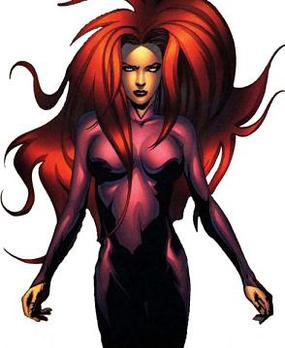
Medusa is a character appearing in American comic books published by Marvel Comics. Created by Stan Lee and Jack Kirby, the character first appeared in Fantastic Four #36 (1965).
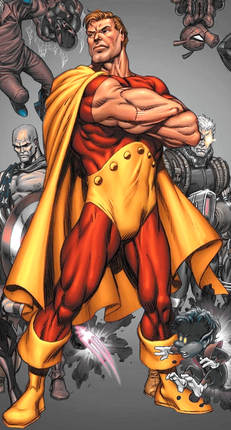
Hyperion is a superhero appearing in American comic books published by Marvel Comics, of which there are several notable versions. Created by writer Roy Thomas and artist Sal Buscema, the original Hyperion made his debut in The Avengers #69. The alternate versions are each from a different dimension of the Marvel Multiverse, and consist of both heroes and villains. Thomas says that the character was intended as a pastiche of DC's iconic hero Superman.

Onslaught is a character appearing in American comic books published by Marvel Comics. He first appeared as a cameo in X-Men: Prime #1 before making his first full appearance in X-Men vol. 2, #53, where he would eventually serve as the main antagonist of the "Onslaught" storyline from then onward.

Captain Universe is a character appearing in American comic books published by Marvel Comics. Created by Bill Mantlo and Michael Golden, the character first appeared in Micronauts #8. Captain Universe is the guardian and protector of Eternity. Rather than a character with a single identity, it is a persona that has merged with several hosts during its publication history.

The Elders of the Universe are a group of supervillains appearing in American comic books published by Marvel Comics. The Collector was the first Elder to appear, and featured in The Avengers #28, but the idea that he was a member of a group known as the Elders was not introduced until The Avengers #174.

The Grandmaster is a fictional character appearing in American comic books published by Marvel Comics. The character first appeared in The Avengers #69. The Grandmaster is one of the ageless Elders of the Universe and has mastered most civilizations' games of skill and chance. Different media appearances depict him as the Collector's brother.
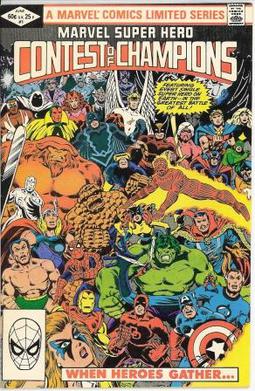
Marvel Super Hero Contest of Champions is a three-issue comic book limited series published from June to August 1982 by Marvel Comics. The series was written by Mark Gruenwald, with art by John Romita Jr. and Bob Layton.
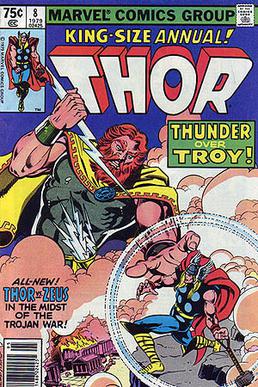
Zeus is a fictional deity, appearing in American comic books published by Marvel Comics. The character is based on the god Zeus in Greek mythology.
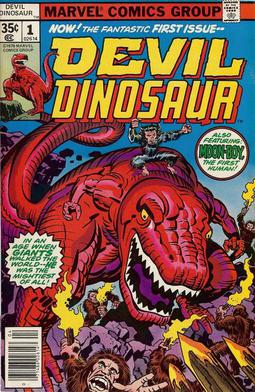
Devil Dinosaur is a character appearing in American comic books published by Marvel Comics. Created by Jack Kirby, the character first appeared in Devil Dinosaur #1. Devil Dinosaur is depicted as resembling an enormous, crimson Tyrannosaurus-like dinosaur. The character and his inseparable ape-like friend, Moon-Boy, are natives of "Dinosaur World," a version of Earth in a parallel universe where dinosaurs and other prehistoric creatures co-exist with tribes of primitive humanoid beings.

The Super-Adaptoid is the name of several fictional characters appearing in American comic books published by Marvel Comics. The character has appeared in over five decades of Marvel continuity and featured in other Marvel-endorsed products such as animated television series and merchandise such as trading cards.

Enchantress is the common primary alias of two fictional characters appearing in American comic books published by Marvel Comics. The first of these is a powerful sorceress with the real name of Amora, one of Thor's greatest enemies. The second Enchantress is the young Sylvie Lushton, who was given great mystic powers by Loki when he created her as a tool for chaos. She models herself after the original Enchantress, Amora.

Collector is a fictional character appearing in American comic books published by Marvel Comics. Created by writer Stan Lee and artist Don Heck, the character first appeared in The Avengers #28, during the Silver Age of Comic Books, and has been a recurring antagonist in various storylines over the course of the ensuing decades.
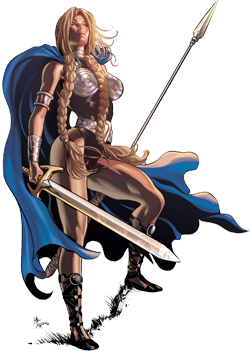
Valkyrie is a superheroine appearing in American comic books published by Marvel Comics. Created by Steve Englehart and Sal Buscema, the character first appeared in Defenders #4. She is based on the Norse mythological figure Brynhildr. Valkyrie became a mainstay of the superhero team known as the Defenders and a close ally and one-time love interest of the god Thor.
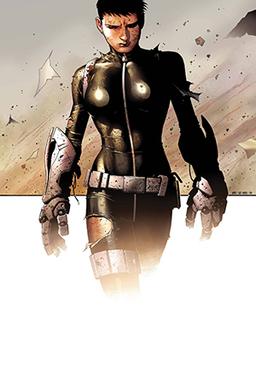
Daisy Johnson, also known as Quake, is a fictional superhero appearing in American comic books published by Marvel Comics. Created by writer Brian Michael Bendis and artist Gabriele Dell'Otto, the character first appeared in Secret War #2. The daughter of the supervillain Mister Hyde, she is a secret agent of the intelligence organization S.H.I.E.L.D. with the power to manipulate vibrations.
Battleworld is a fictional patchwork planet appearing in American comic books published by Marvel Comics. It serves as the setting in Secret Wars comic book storyline published by Marvel Comics.

Neptune, also called Poseidon, is a fictional character appearing in American comic books published by Marvel Comics. The character is based on the Roman God with the same name and his Greek counterpart. Neptune is the god of the sea in the Olympian pantheon, as well as patron god over Atlantis. Neptune first appeared in Tales to Astonish #70 and was adapted by Stan Lee and Gene Colan.

Metal Master is the name of two fictional characters appearing in American comic books published by Marvel Comics.

Shamrock is a fictional comic book superheroine appearing in American comic books published by Marvel Comics. Created by Mark Gruenwald, Bill Mantlo, Steven Grant, and John Romita Jr., the character first appeared in the comic book Marvel Super-Heroes: Contest of Champions #1.
Nyx is a fictional character appearing in American comic books published by Marvel Comics. The character is based on the Greek goddess of the same name. She first appeared in Avengers: No Road Home #1 and was created by Al Ewing, Jim Zub, Mark Waid, and Paco Medina.


















